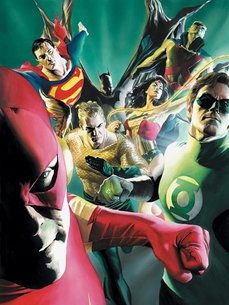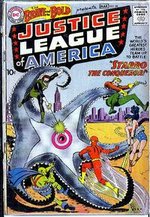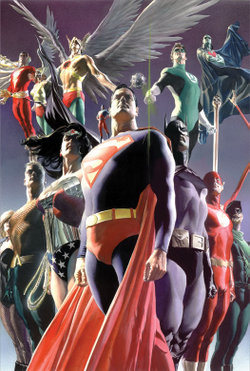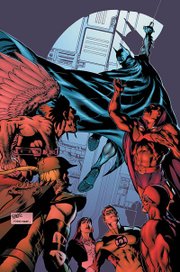The original, and arguably most popular, line-up is Superman, Batman, Wonder Woman, Flash, Green Lantern, Aquaman, and Martian Manhunter. The League has also included Green Arrow, Hawkman, Atom, Elongated Man, Firestorm, Zatanna, Captain Marvel, Blue Beetle, Plastic Man and dozens of others.
The team first appeared in The Brave and the Bold #28 (1960). Although series featuring the League have occasionally gone stale and been subjected to ill-fated experiments, the team has been fairly popular since inception.
The team's concept was loosely adapted into the cartoon series Super Friends (1972-1985) and more directly into the series Justice League (2001-2004) and Justice League Unlimited (2004-present).
Between the mid-1980s and mid-1990s, the team had also gone by the names Justice League America and Justice League International.
History
Silver and Bronze Age
The original team first appeared in The Brave and The Bold #28 (1960) as a revival of the Justice Society of America (or "JSA") under a new, more dynamic name of "League" and soon gained its own title that same year. The creator was a writer named Gardner Fox, who was inspired by the Justice Society to create a similar, contemporary concept, and who decided upon the word "league" influenced by the National Football League and Major League Baseball. The artist for the first five years of the comic was Mike Sekowsky.
During this period, the team operated from a secret cave outside of the small town of Happy Harbor. They also had a team "mascot" that tagged along on some missions, a teenage sidekick named Snapper Carr, noted for speaking in "hipster" dialect. Snapper had earned this status in the team's first appearance, after helping them to defeat the villain of that story, Starro the Conqueror (a giant starfish bent on conquering Earth).
The JLA comic was initially amongst the most popular of DC Comics' publications, but by the end of the 1960s, it had become overshadowed by Marvel Comics' equivalent super-team, the Avengers, in sales and quality. Various changes were made as an attempt to boost sales; the first of these changes included dropping Snapper as a "mascot." As told in Justice League of America #77 (December 1969), Snapper was tricked into betraying the secret location of the cave headquarters to the Joker, which resulted in his resigning from the team in shame. After this, the Justice League was shown moving into a new orbiting space station "satellite" headquarters (in Justice League of America #78, February 1970). The 1970s would present the team's membership as occasionally varying in makeup and size.
Those involved in producing the Justice League of America comic during the 1970s included writers Cary Bates, E. Nelson Bridwell, Steve Englehart, and (longest of them all) Gerry Conway, while the art chores were primarily handled by Dick Dillin. The JLA comic had a brief spike in popularity in 1982 when artist George Pérez stepped in following Dillin's death, but the commercial success was short-lived.
In 1984, in an attempt to emulate the success of DC's most successful comic at that time, The New Teen Titans, an editorial decision was made to have most of the regular members leave the team, to be replaced by young unknowns. It was also decided to have the team move from its orbiting satellite headquarters into a new base located in Detroit, Michigan. This move was highly unpopular with readers, who dubbed this period of time the "Justice League Detroit" era. Created by Conway and artist Chuck Patton, this version of the Justice League was eventually disbanded by writer J.M. DeMatteis and artist Luke McDonnell. The final issue of the original Justice League of America series was #261.
Modern Age
The team was rebuilt in the 1987 company wide crossover miniseries, Legends. This new team was given a less America-centric mandate than before, and was dubbed the Justice League International (or "JLI" for short); the new comic was written by Keith Giffen and DeMatteis, with art by Kevin Maguire. This new and very popular series added a quirky sense of tongue-in-cheek humor to the stories, with an occasional slant toward excessive silliness.
In 1989 Secret Origins #32 updated the JLA's classic origin from Justice League of America #9 (1962). See more below in "Origin of the JLA".
The Justice League titles expanded to a total of five by the early 1990s: Justice League of America (formerly Justice League International), Justice League Europe, Justice League Task Force, Justice League Quarterly, and Extreme Justice. By the 1990s, however, with the departure of Giffen as writer, the humor prevalent in the early JLI-era had disappeared in favor of more serious stories, and as the commercial success of the series faded, each of the titles were cancelled.
In 1997, a new Justice League series titled JLA debuted, written by Grant Morrison and with art by Howard Porter and John Dell (though the new version of team first appeared in the miniseries JLA: A Midsummer's Nightmare, written by Mark Waid and Fabian Nicieza). This series, in an attempt at a "back-to-basics" approach, used as its core the original and most famous seven members (or their character successors) of the team: Superman, Batman, Wonder Woman, Aquaman, Flash III (Wally West), Green Lantern V (Kyle Rayner), and the Martian Manhunter. Added to this core roster was the character Plastic Man, as well as a new headquarters for the team, the "Watchtower", based on the moon. Morrison introduced the idea of the JLA allegorically representing a pantheon of gods, with their different powers and personalities. Since Morrison left the title, other writers and artists have taken over, though none with the success of Morrison's version of the Justice League.
Read more at Wikipedia.org





